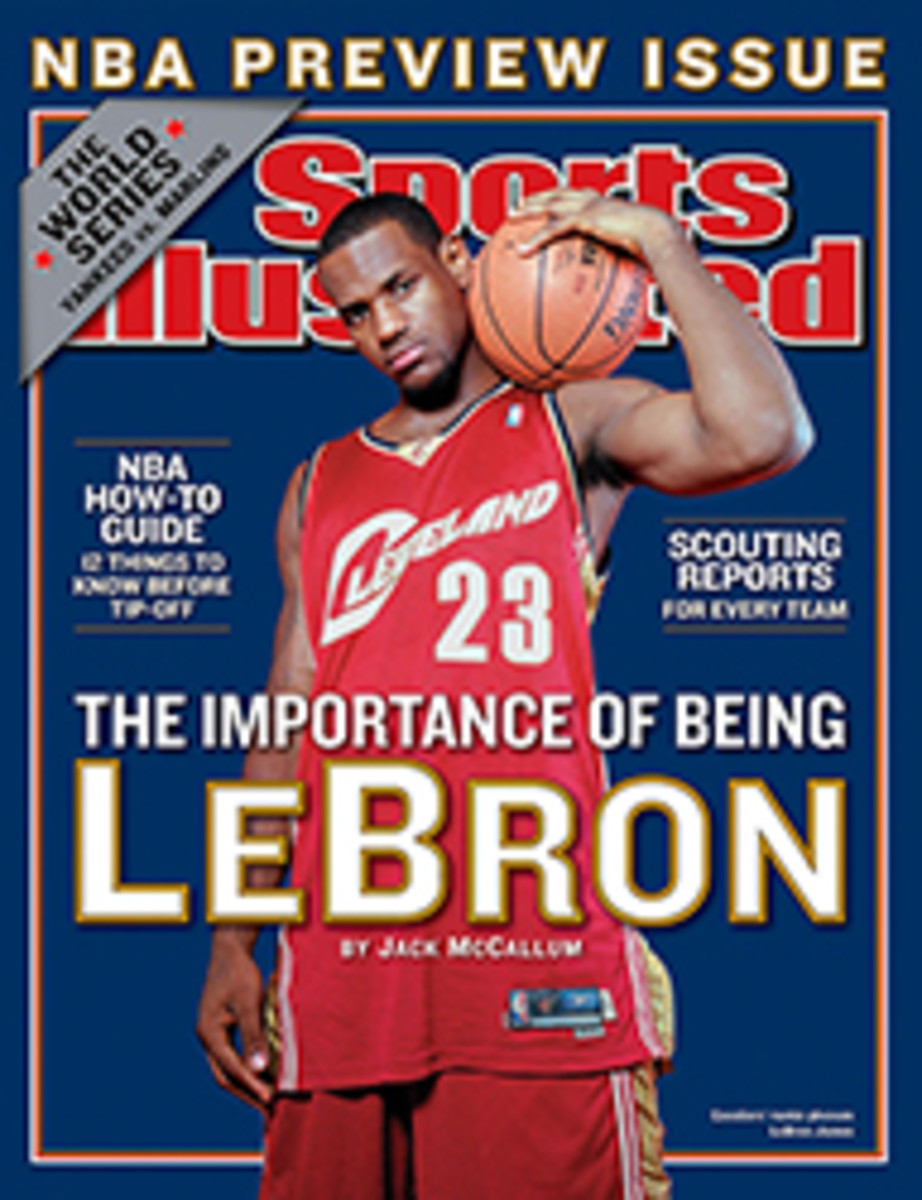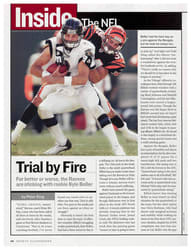
Grit And Bear It The IRONMAN TRIATHLON proved again that it is the world's foremost test of athletic endurance
This magazine was complicit in the creation of Ironman. It was far
from fated that the mother of all triathlons begin in Hawaii. It
happened because a dozen hypercompetitors at a 1977 Oahu banquet
for an around-the-island running event got into a debate sparked
in part by an SI story that had called cyclist Eddy Merckx the
world's fittest athlete. The competitors argued about which
sport's athletes were the fittest, and they ended up challenging
one another to an event that would combine Oahu's longest tests
of endurance: a 2.4-mile open-water swim, a 112-mile
around-the-island bike race and a 26.2-mile marathon. The first
Ironman, with 15 participants, was held the following February.
A year later SI again unwittingly spurred interest in the event.
After the second Ironman, in 1979, the magazine's Barry McDermott
wrote a 10-page feature focused on '78 winner Gordon Haller, '79
champion Tom Warren and two-time runner-up John Dunbar, a former
Navy Seal. Wrote McDermott, "They all shared a common reason for
being there (some called it a curse): an addiction to inordinate
amounts of exercise."
McDermott brushed their every stride with sterile pathology. Of
Warren, who finished in 11:15:56, McDermott declared, "Every time
[he] wins, he is cursed to try again. With thirst unslaked, this
albatross around his neck, he sails on and on."
How deliciously wrong that was. When the article appeared,
thousands of runners, swimmers and cyclists read of the Ironman
competitors' compulsions and said, "Whoa, whoa, I chart my pulse
rate. I keep a log of every mile I cover, every calorie I eat.
People tell me I have no pain threshold. And where, exactly, is
the 'curse' in trying again?"
One end of Our Great Bell Curve turned out to be tireless
metabolic furnaces, all thinking they were perfectly sane. They
flocked to subsequent Ironman races in reinforcing
profusion--especially after ABC began televising the event in
1980--until organizers had to impose strict qualifying standards
for the field. (This year there were 1,251 men and 397 women.)
Last Saturday's 25th-anniversary race, won by Peter Reid and Lori
Bowden of Canada, was the world championship of an international
Ironman series of 24 races. A shorter triathlon is in the
Olympics. Over the years roughly 500,000 have completed the
daunting, 140.6-mile Ironman distance. That old curse now looks
like a blessing.
What fires one's metabolism? Science says our mitochondria, the
tiny organelles in every cell that manipulate oxygen and food to
release energy. If you inherit good ones, you can go forever.
Those so gifted have always been with us, but as running, biking
and swimming boomed in the 1970s, they formed a new meme pool.
And out popped the Ironman triathlete.
"I was a swimmer at UC Davis," recalls Dave Scott. "I wasn't
fast, but I had an uncanny ability to recover." He was a fair
runner, a decent biker, so he entered the Ironman in 1980 and
slashed almost two hours from Warren's record by finishing in
9:24:33. A mitochondrial miracle.
He exploited his remorseless competitive nature to take six
Ironmans in eight years and changed everything, even himself.
Crossing that first finish line, Scott displayed the smooth
subcutaneous suet of a swimmer. But year by year, learning more
about training and nutrition, he grew greyhound lean. His best
time, 8:10:13, would be almost an hour and a quarter faster than
his first.
Needing room for the growing field of competitors, the race moved
to Kona on the Big Island in 1981. The stark, brutal course has
been Hawaii's true gift to grit. The Kailua Bay swim start seems
to be 1,648 flailing tuna fleeing a massive purse seine. The
heartless, glaring lavascape of the Queen Kaahumanu Highway and
the battering winds off Mauna Kea are wearing, drying,
overheating. Scott led a generation in figuring out how to endure
them.
But would the race ever appeal to the general public? The answer
came on Feb. 6, 1982. Julie Moss, 23, rode to a huge lead off the
bike and was eight minutes ahead of Kathleen McCartney with eight
miles to go in the marathon. But Moss didn't pace herself. A
quarter mile from the finish she collapsed and sat staring at the
street for three minutes. She staggered on and fell again with
100 yards to go, then 50, then 15. McCartney ran past Moss to win
without knowing Moss was lying there, five steps from the end.
Twenty-nine seconds later, Moss crawled in, her hand clawing at
the painted stripe as if it were a lifeline.
"Never had an athlete struggled so graphically, so desperately,
for such a long period of time in front of the camera as did
Julie Moss," ABC's Jim Lampley later wrote in The Ironman
Triathlon: The 25th Anniversary.
Since that race there's been discussion about what Moss's bravery
meant to the event and to her. Ironman has a bifurcated heart. On
one hand, it loves and rewards tough, masterly performers such as
Scott. But the distance is so great, the elements so draining,
that any participant's ordeal may become a weeping, bleeding
affirmation of the power of human will. So Ironman also cherishes
the survivor. And caught in that dichotomy is Julie Moss.
In going so hard for a win, Moss became a symbol of the other end
of the spectrum, a crawling, piteous object, not of boundless
energy but of total expenditure. She hated that. "It took me a
long time to own my image in that race," said Moss. "I represent
something to people, but it's not about being an amazing athlete.
It's about the personal qualities to not give up when things get
really hard."
"I don't know if [Moss's finish] was our defining event," says
Scott. "I resist that. That's what TV looks for. That angers me.
It's a race, not a survival event."
As the best races do, it allows the sensible to outlast the
neurotically driven, or even the overly emotional. For years
Scott had defeated Mark Allen, an equal talent, but one given to
expensive attempts at breaking away. Finally, in 1989, in
Ironman's greatest battle, Allen stayed a few meters from Scott
through the swim, bike and 24 miles of the run, waiting, waiting,
when his every fiber screamed at him to go. "God, it was hard to
reconcile myself to that," said Allen, but he was rewarded with
the first of what would be six victories, in a record 8:09:15.
Cheering him as he raced away over the last two miles was his
fiancee, Julie Moss. Who better to fear for him? Who better to
exult?
Scott and Allen's only female peer has been Zimbabwe-born Paula
Newby-Fraser. Between 1986 and '96 she won eight times and became
the only woman to break nine hours, her best being 8:55:28 in
'92. Notwithstanding Belgium's Luc Van Lierde's lowering the
men's record to 8:04:08 in '96 and Switzerland's Natascha
Badmann's winning four times between '98 and '02, no new plateaus
have been summited since the big three.
On Saturday, after easing away from Badmann in the marathon to
win by five minutes, Bowden arrived at the press conference hung
with yards of royal maile leaves and crowned with roses and
orchids.
"You're beautiful," cried Badmann.
Like most finishers, Bowden seemed almost bemused by this rare
moment for an Ironwoman--coming to rest. But then she grabbed a
greasy slice of pizza, her furnace kicked in again, and, asked
whether she was going to cut down on racing, she said, "This
event of ours is so long that you have to love it. I want to do
more long ones, I really do."
Then she got up and began planning her training, thirst slaked,
garlands around her neck, sailing on and on, on wings of perfect
sanity.
COLOR PHOTO: PHOTOGRAPHS BY DAVID WALBERG WINNING LOOK Reid was Saturday's victor.
COLOR PHOTO: PHOTOGRAPHS BY DAVID WALBERG EVERYBODY IN THE WATER The first leg of the Ironman is the 2.4-mile open-water swim, which takes place in Kailua Bay.
TWO COLOR PHOTOS: PHOTOGRAPHS BY DAVID WALBERG GRUELING Chris Lieto (above) was totally spent after finishing 13th; Nina Kraft held her form in the 112-mile ride.
The distance is so great, the elements so draining, that any
participant's ordeal may become a weeping, bleeding affirmation
of the power of human will.
For more about sports in Hawaii and the other 49 states, go to
si.com/50.

